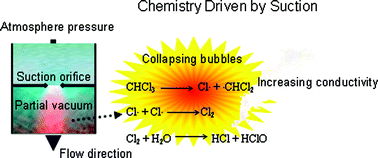The use of suction rather than positive pressure hydrodynamic cavitation is suggested as an energy efficient green technology. The restriction orifice for creating hydrodynamic cavitation is fixed on the suction side of the pump, and the upstream and downstream pressures are kept low, at atmospheric pressure and partial vacuum, respectively. Energy efficiency is much better by suction than by extrusion with the same pump. As an indicator of cavitational intensity, the conductivity of the aqueous solution increases linearly with the decomposition of chloroform driven by suction. The concentration of Cl− was found to synchronously rise with the increase of conductivity. The observed rates vary polynomially with the suction pressure and the solution temperature. Suction also facilitates the two-phase mixing, and promotes the ozonation of phenol, due to high-speed jetting of liquid along with the associated shock waves induced by collapsing cavitation. These results indicate that hydrodynamic cavitation induced by suction as a green tool is particularly promising especially for heterogeneous reactions, such as biodiesel synthesis, oxidation of organics, extraction and emulsification.

You have access to this article
 Please wait while we load your content...
Something went wrong. Try again?
Please wait while we load your content...
Something went wrong. Try again?


 Please wait while we load your content...
Please wait while we load your content...